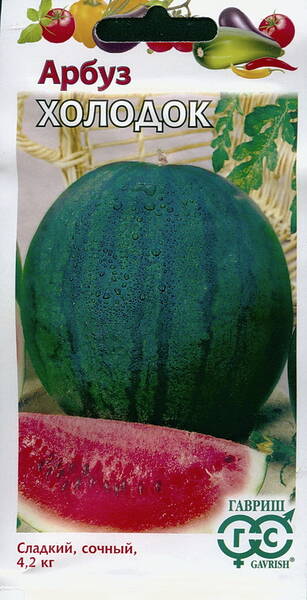Koe kesäpäivän viileä ja makea maku Vesimeloni "Holodok"-vesimelonilla! Kuin virkistävä keidas kuumana iltapäivänä, tämä lajike tarjoaa sinulle unohtumattoman kokemuksen. Kuvittele auringonlaskua, ystävien naurua ja viipale Holodok-vesimelonia kädessäsi. Täydellinen kesämuisto odottaa!
Mehukas ja makea! – näin voisi kuvailla tämän ihanan vesimelonin makua. Kuvittele leikkaavasi sitä, ja kirkkaanpunainen, tiheäsyinen hedelmäliha houkuttelee mehukkuudellaan. Lievä hapokkuus lisää vain ripauksen pikanttisuutta tehden mausta todella unohtumattoman. Se on kuin kesän aurinko puristettuna yhteen suupalaan!
"Holodok"-lajikkeen pääominaisuudet:
- Tyyppi: Keskimyöhäinen lajike
- Kypsymisaika: 85–97 päivää itämisestä
- Kasvi: Voimakas, pitkäripsinen (pääverso on yli 5 m korkea)
- Hedelmän muoto: Pitkänomainen-pallomainen, heikosti segmentoitunut
- Hedelmän väri: Vihreä mustanvihreillä raidoilla
- Hedelmän keskimääräinen paino: 4,2 kg
- Malto: Intensiivisen punainen, tiheäjyväinen, mehukas, makea ja hieman hapan
- Kuori: Paksu ja tiheä, mikä takaa hyvän kuljetettavuuden
- Siemenet: Suuria, vaaleanruskeita
- Saanto: 5–7 kg/m²
Tekniset tiedot:
- Tautienkestävyys: Korkea vastustuskyky antraknoosia, härmää ja fusarium-sientä vastaan. Tämä tarkoittaa, että vesimelonisi ovat terveitä ja vahvoja ja ilahduttavat sinua runsaalla sadolla.
- Kuljetettavuus: Erinomainen. Voit kuljettaa vesimeloneja turvallisesti pitkiä matkoja ilman huolta niiden myyntikelpoisen ulkonäkönsä menettämisestä.
- Säilyvyys: Erinomainen. "Holodok"-vesimelonit säilyvät jopa 3–5 kuukautta, ja niiden maku ja tuoreus säilyvät. Kuvittele, kuinka miellyttävää on nauttia kesän mausta jopa kylminä talvipäivinä!
Viljelyn ja käytön ominaisuudet:
"Holodok"-vesimeloni on suhteellisen helppo kasvattaa, mutta maksimaalisen sadon saamiseksi on suositeltavaa noudattaa muutamia yksinkertaisia sääntöjä:
- Kylvö: Kasvatetaan taimilla tai suoraan maahan kylvettynä.
- Sijainti: Viihtyy aurinkoisissa, tuulensuojaisissa paikoissa.
- Maaperä: Vaatii ravinteikasta, hyvin vettä läpäisevää maaperää.
- Kastelu: Säännöllinen kastelu, erityisesti hedelmien muodostumisen aikana.
- Ohjeet: Suositellaan tuoreena nautittavaksi. Nauti jokaisesta suupalasta tätä herkullista vesimelonia, tunne sen sulavan suussasi ja tarjoavan virkistävän makeuden!
"Holodok"-vesimeloni ei ole mikä tahansa vesimeloni; se on kesän, auringon ja ilon symboli! Kasvata sitä puutarhassasi tai osta sitä kaupasta, ja se varmasti koristaa pöytääsi ja tarjoaa unohtumattoman makuelämyksen. Anna sen rapean makeuden viedä sinut hetkeen, jolloin aurinko paistaa ja elämä on täydellistä.
Nauti Holodok -vesimelonista – kesän paras ystävä!
* Tehokas menetelmä vesimelonin varhaiseen tuotantoon on taimimenetelmä.
Koska taimien kasvatus tällä tavalla vauhdittaa kasvien kehitystä, ensimmäiset hedelmät voidaan korjata 10–20 päivää aikaisemmin kuin kylvettäessä siemenet suoraan maahan. Tämä moninkertaistaa varhaisen sadon ja lisää merkittävästi hedelmien kokonaissatoa.
Vesimelonin taimia kasvatetaan puolilämpimissä, varhaiskasvihuoneissa tai muovikasvihuoneissa toisena satona vihreiden vihannesten tai varhaiskaalin taimien jälkeen. Niitä voidaan kasvattaa myös sisätiloissa, ikkunalaudoilla ja parvekkeilla.
Taimet kasvatetaan samankoostumukseltaan vihanneskasvien ravinneruukuissa, 8x8 tai 10x10 cm kokoisissa paperikupeissa. Taimet ovat 30–35 päivää vanhoja (itämisestä). Kastele taimia runsaasti ennen istutusta ja lisää vettä kuoppiin istutuksen yhteydessä. Istutus noudattaa samaa kaavaa kuin kylvämällä siemenet suoraan maahan. Siirrettyjen taimien myöhempi hoito on sama kuin kylvettyjen taimien.
Hedelmien korjuu.
Vesimelonit korjataan tyypillisesti niiden kypsyessä. Pitkän matkan kuljetukseen tarkoitetut vesimelonit korjataan muutamaa päivää ennen niiden täyttä kypsyyttä, kun taas paikallisesti ja siementuotantoon käytettävät vesimelonit korjataan täysin kypsinä. Kypsien hedelmien lopullinen, täydellinen sato edistää jäljellä olevien hedelmien parempaa kasvua ja kypsymistä. Siksi sadonkorjuun viivästyttäminen (tai kiirehtiminen) on väistämätöntä.
Kokeneet meloninviljelijät määrittävät vesimelonien kypsyyden silmämääräisesti niiden ulkonäön perusteella. Kypsyessä kuoreen kehittyy lajikkeelle ominainen kiilto ja kimmoisuus, kuoren väri ja kuvio kirkastuvat, ja maassa olevaan kuoren kohtaan muodostuu keltainen täplä. Varsi ja sen lähellä oleva kärhi kuivuvat hedelmän kypsyessä. Kun kypsää vesimelonia lyödään kämmenellä tai heilutetaan, siitä kuuluu vaimea ääni, ja puristettaessa (mitä ei suositella) hedelmäliha rätisee.
Kasvien sijoittelu.
Vesimeloni (kuten muutkin melonit) antaa parhaat tulokset kylvettäessä sitä koskemattomalle tai kesantomaalle tai monivuotisten heinien jälkeen, jotka ovat niiden parhaita edeltäjiä. Puutarhapalstoilla (etenkin alueilla, joilla ei ole riittävästi lämpöä) vesimeloni tulisi istuttaa aurinkoisille alueille, joilla on etelään, kaakkoon tai lounaaseen suuntautuva rinne. Sitä voidaan kasvattaa myös kasvihuoneissa ja nuorten hedelmätarhojen rivien välissä, joita puutarhakasvit eivät varjosta.
Lannoitteiden levitys.
Tehokkain on mineraali- ja orgaanisten lannoitteiden yhdistelmä. Parhaat orgaaniset lannoitteet vesimelonille ovat viime vuoden lahonnut lanta tai komposti. Tuore lanta, erityisesti suurina annoksina, heikentää hedelmän makua ja kasvin vastustuskykyä tauteja vastaan. Sitä on käytännöllistä levittää vesimelonille vain pienillä palstoilla pohjoisilla viljelyalueilla, missä sitä ei käytetä niinkään lannoitteena kuin maaperän eristämiseen ja maaperän ja ilman rikastamiseen hiilidioksidilla, mikä parantaa mikroilmastoa. Tässä tapauksessa lanta levitetään keväällä ennalta kaivettuihin vakoihin tai kuoppiin (kesanto) ja peitetään sitten mullalla 10–15 cm syvyyteen tai kesantokuoppiin 15–20 cm syvyyteen.
Vesimelonin siemenet kylvetään sivuttain vakojen suuntaisesti tai kesannon keskelle. Voit luoda 210–270 cm leveitä penkkejä, levittää lantaa ja sekoittaa sen penkin keskelle (pituussuunnassa) tehtyyn vakoon ja kylvää kaksi riviä vesimelonia sekoitetun lantavaon kummallekin puolelle. Penkin riviväli on 70–90 cm ja vierekkäisten penkkien riviväli on 140–180 cm. Näillä menetelmillä lannan kulutus on noin 6–8 kg neliömetriä kohden.
Parhaita mineraalilannoitteita vesimelonille ovat superfosfaatti, ammoniumnitraatti ja kaliumsuola. On tärkeää huomata, että liialliset typpilannoitteet vaikuttavat negatiivisesti vesimelonin makuun ja ravintoarvoihin, mikä johtaa erityisesti nitraattien kertymiseen, jotka ovat haitallisia ihmisille. Siksi on parasta olla käyttämättä liikaa typpeä tai muita lannoitteita, etenkään hedelmäkauden aikana.












